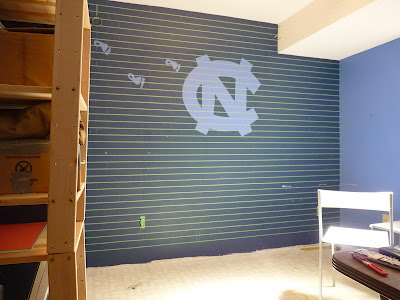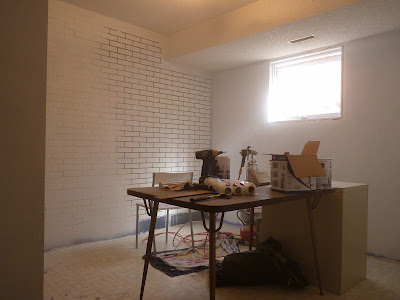ads
How To Make a Faux Exposed Brick Wall
I've kinda got an thing for exposed brick walls in older buildings. I love the texture and character they bring to a space. I really wanted an exposed brick wall in my new studio, the only problem was that I didn't have a brick wall to expose. So I decided to try something kind of off-the-wall (pun intended) and create my own, or rather the effect there-of.
If you would like to do something like this in a space of your own, I would suggest that you make it as real as possible. I'm not a faux-snob, but if I'm going to go faux, I want to mimic what's real as closely as possible. The exterior of my house does have brick on the lower portion making a faux-brick wall on an exterior wall of a room in my basement more believable. I wouldn't suggest doing this in a space where brick just wouldn't be.
Next, ensure that having a brick wall in your space will fulfill appropriate design elements and principles. Give it a purpose. I wanted to create light and space in my little studio by turning the room for the most part into a pure white space. To successfully pull off a mainly monochromatic colour scheme, I needed to add more to the space by way of shape, line and texture in the absence of colour to create variety and avoid too much repetition. An exposed brick wall fit the bill.
MATERIALS:
- 2 gallon pails of interior stucco
- 1/4" painting tape (4 rolls for this particular wall)
- Piece of cardboard
- Ruler
- Pencil
- Exacto blade
- T.S.P. solution
- Fine sandpaper and sanding block
- Large dry-wall trowel
- Sea-sponge
- Putty knife or small dry-wall trowel
- Chalk-line
- A partner (this is a definitely a 2 person operation)
METHOD:
1) Prep Your Wall:
Remove any electrical outlet or light switch face plates, etc, and tape over remaining parts with painter's tape. Using fine sand-paper and a sanding block, give the surface of your wall a light sand, and clean up the dust. Using a rag and T.S.P. solution, thoroughly clean the surface of your wall and allow to dry.
2) Mark Your Wall:
Create a stencil: Using a ruler, pencil and Exacto blade, create a brick-sized stencil out of a piece of cardboard. I used the dimensions of the brick on the exterior of my house (7.5" x 2.25") to make my faux wall more believable. Using your cardboard stencil, and starting in the top left corner of your wall, mark the width of your brick stencil all the way down the left side of your wall, then do the same thing down the right side of your wall (or create 2 stencils, and have your partner do the right side while you do the left!)
Mark your horizontal lines: Have your partner hold the end of a chalk-line at the first mark on the top right corner of your wall. Extend the chalk line along the length of your wall, and hold it firmly at the first mark on the top of left corner of your wall. Snap the chalk line against your wall to create a straight, horizontal line all the way across your wall. Repeat this process with all your marks from the top to the bottom of your wall.
Draw the bricks: Starting at the top left corner of your wall, hold your cardboard brick stencil in-between the chalk lines, and use your pencil to mark the vertical line at the end of the stencil connecting the chalk lines at the top and bottom of your stencil. Move your stencil along the chalk lines to the right, aligning the beginning of your stencil with where you just marked the end, and use your pencil to mark the end of the stencil again. Repeat this process until you've made it across the length of your wall.
At the beginning of your second row, begin with only half your stencil, and then continue on with the full stencil in order to create the staggered brick pattern. Continue to mark the brick pattern from the top to the bottom of your wall.
3) Tape Your Lines:
Starting at the top left corner of your wall, firmly press 1/4" painting tape along the bottom of your first chalk line across the length of the wall. *Tip: try to keep the tape in one continuous piece as much as possible, and leave some extra length at the beginning and end* Repeat this process always taping along the bottom of your chalk lines from the top to the bottom of your wall.
Once you have finished taping your horizontal lines, you can begin taping your vertical lines, firmly pressing your 1/4" painting tape to the left of your vertical mark, beginning and ending your tape in the middle of the horizontal taped lines. Repeat this process always taping along the left of your vertical lines from the left to the right of your wall.
4) Apply Stucco:
Using a large dry-wall trowel, gently smear interior stucco mixture over the wall, being careful not to disturb the tape. Smooth to ensure even coverage. *Tip: the thicker you can make the stucco up to 3/8" the more realistic your faux brick will look.*
5) Texture Stucco:
When the stucco mixture is beginning to dry (becomes slightly soft, but not sticky), gently dab it with a damp sea-sponge. Keep the indentations made with the sponge in the stucco, but smooth any protrusions created by the sponge with a putty knife. I found it useful to follow along 1 section behind my Dad, who was doing the stucco spreading.
6) Remove Tape:
When stucco mixture is dry to the touch but still soft, begin removing the tape by gently pulling the horizontal tape lines from the excess on the side from the left to the right side of the wall. Use your sea-sponge and putty-knife to touch up any bricks that may require it after the tape is removed. Allow stucco mixture to dry and harden thoroughly.
7) Prime:
Apply 1 generous coat of primer to your faux brick wall, and allow to dry. *Tip: when painting heavily textured surfaces such as this, I find it useful to use my paint spray-gun, but it can be done with a brush and a roller designed for heavy textures*
8) Paint:
Paint your faux brick wall with 2 coats of paint allowing paint to dry in-between coats. Allow final coat to dry and remove tape from any electrical outlets or light switches and replace face plates.
ads
About Me
Powered by Blogger.
Blog Archive
-
▼
2013
(26)
-
▼
November
(26)
- DIY Recycled Storage Ottoman
- Re-Upholstering Furniture Part 2: Upholstering
- Re-Uphostering Furniture Part 1: Refinishing Wood
- Painting Furniture
- Installing Molding Panels
- Argyle-Style Feature Wall Tutorial
- Closet Bookshelf
- DIY Nursery in Pink & Grey
- Antique Ivory
- Upcycled Shaker-Panel Cabinet Doors
- How To Replace Interior Doors
- Painting Stripes
- Cutting and Installing Crown Molding
- DIY Upcycled Shoe Cubby
- Design on a Dime
- Simple Tufted Headboard
- Kinda-Custom Storage Cabinet
- Pumpkin Week: Decorating Outside
- Hand-Painted Moroccan-Lattice Wall Stencil
- Painted Kitchens
- Bi-Fold Closet Door Makeover:
- DIY: Ruffled Throw
- Closet-To-Nook Conversion with Custom Shelf
- How To Make Your Own Headboard
- How To Make a Faux Exposed Brick Wall
- DIY Tailored Slip-Cover
-
▼
November
(26)














